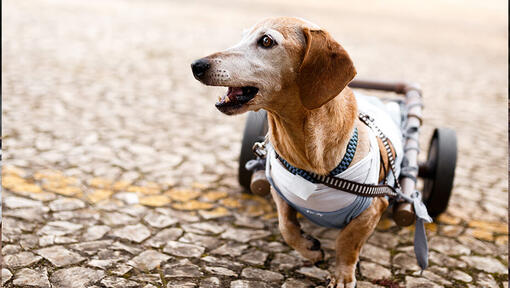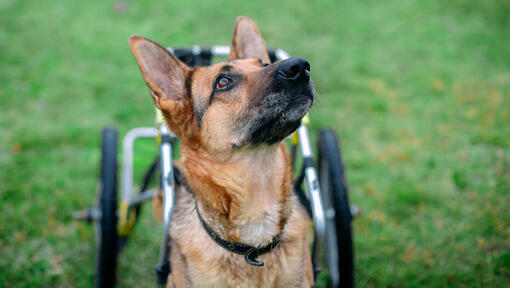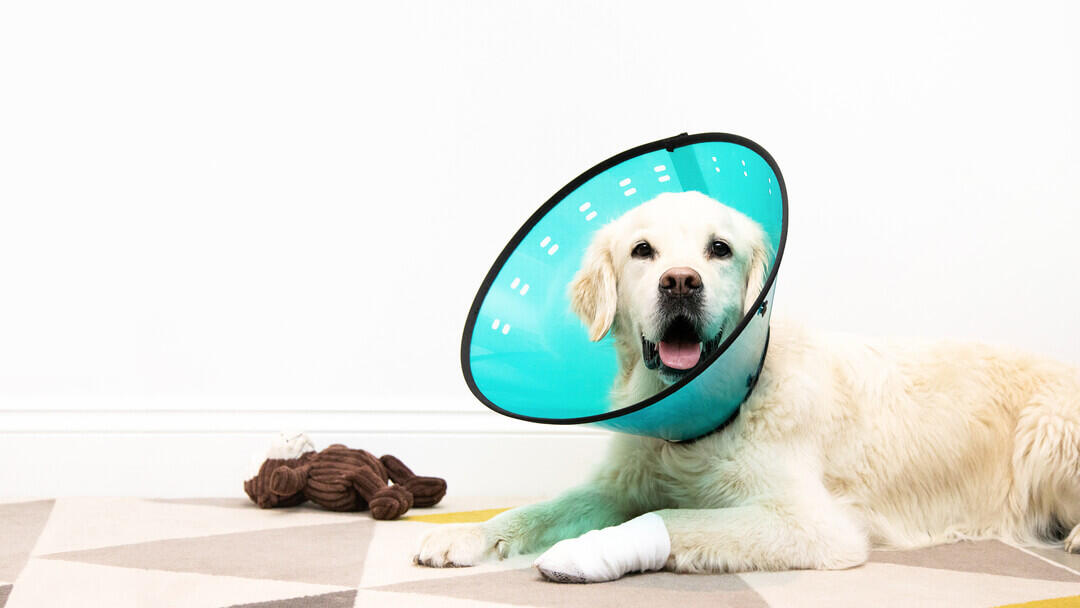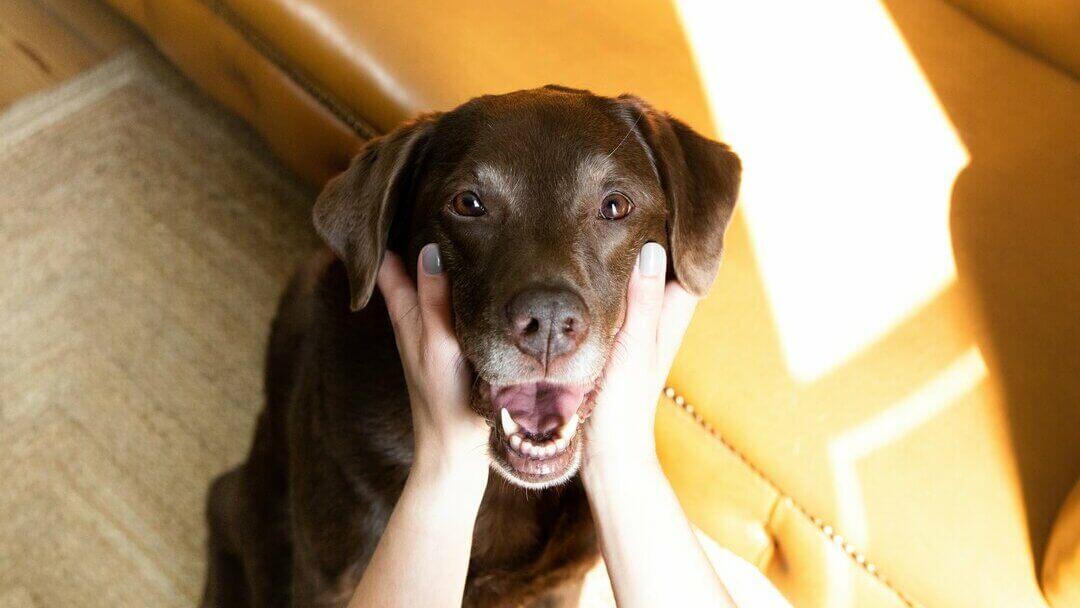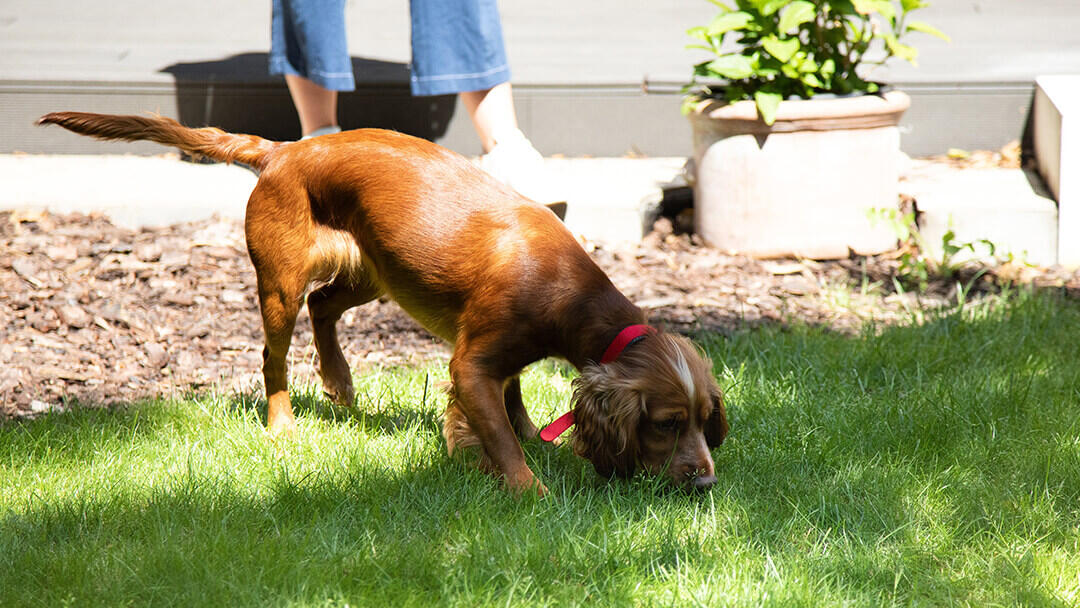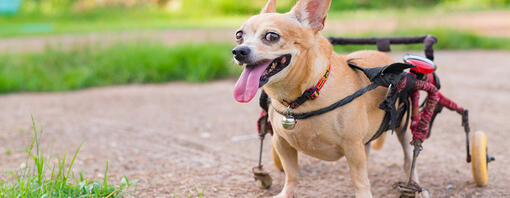
Paralysed dogs often take a lot of special care to ensure they can continue living their lives happily and healthily. That’s why the experts at Purina have created this article to tell you everything you need to know about looking after them, as well as dog wheelchair advice for helping those with hind leg paralysis get back on their feet.
Although sometimes the only option for your dog is an upsetting one, in other cases rehabilitation can take place. Dog paralysis is an inability to use one or more limbs, usually due to a spinal cord injury. This can of course be distressing for you, and you may have to make difficult decisions. Your dog’s treatment and prognosis will depend on the cause of their paralysis and the limbs affected, and your vet will advise you on the chances that your dog will regain use of their limbs again.
Looking after a paralysed dog is a big commitment and can at times be difficult. If you work long hours or have a busy family life, you may not be able to provide enough care. Rehabilitation centres are available in some areas; here, your dog will be looked after until they are well enough to be cared for at home. Larger veterinary practises, too, might hospitalise dogs for longer periods.
Caring for a paralysed dog
Dog paralysis is often life-changing. You may need to empty your dog’s bladder for them, at least initially, by applying gentle pressure on their abdomen – your vet should show you how to do this, and watch you while you practise. In time, some dogs will regain urinary function.
Your paralysed dog should always be kept clean and dry, and moved around regularly to prevent the development of skin ulcers. Your dog’s vet or physiotherapist can advise you on the best bedding for them, but you should always remember to check it for signs of soiling or wetness. In some cases, slings or harnesses might keep your pet mobile – various kinds are available.
Physiotherapy is a vital resource; muscle tone and strength need to be maintained following paralysis in dogs. Physiotherapy should be performed by a trained animal physiotherapist, and you may be given exercises to do at home as well. Some types of dog insurance will provide payment for physiotherapy, so check what’s included in your cover.
Long term paralysis in dogs
In some cases, long term paralysis in dogs occurs (often affecting the hind limbs) and if this is the case, certain factors must be considered to make sure your dog is comfortable. Many owners, on considering their dog’s happiness and comfort, choose to have them put to sleep; this is a very personal decision to be talked through carefully with your vet.
Larger disabled dogs may be difficult to move around, and dogs with hind limb paralysis may have varying degrees of urinary or defecation problems that you will need to manage. It is important to carefully consider your dog’s quality of life, not just from your point of view but theirs: euthanasia may be the kindest option in some cases.
In any scenario, if you’re unsure about your paralysed dog’s care, speak to your vet – they’ll know the best way to help, taking yours and your dog’s needs into consideration. Even if it’s not easy, you should always know that you’re just doing the best you can for your friend!
Wheelchairs for dogs with mobility impairments
Sometimes wheelchairs are available for animals with hind limb paralysis, offering a welcome return of movement. In fact, thanks to such inventions, some dogs learn to jog, fetch and play as happily as they did before their injury! Bear in mind that the use of such equipment should be supervised by your vet and doesn’t suit all dogs, usually only lighter, smaller breeds. For disabled dogs that do adapt to wheels, inspired owners can assemble ramps for access to raised porches and other areas, letting their dog explore just as much as before.
Choosing a dog wheelchair
The kind of wheelchair you need will depend on your dog’s condition, mobility and size. There are lots of companies who supply wheels for dogs, and your vet should be able to recommend reputable providers. They should offer a range of wheelchairs and take the time to help you understand which is right for your dog.
The wheels should be specially made to fit your dog and allow them to walk and move about at the right height. There are also different types of wheels, depending on the terrain your dog will be travelling on and how long the walks are likely to be.
Finally, dogs with wheels have different options for harnesses and stirrups to support their legs. Some dog wheelchairs come with elastic stirrups so your dog can continue to use their legs if there is still some mobility. This will encourage your pooch to maintain muscle mass and mobility even when using the wheelchair.
Training a dog to use wheels
Once you’ve got a dog wheelchair, it’s time to get your dog used to using it. Remember that walking with wheels can be a big adjustment for a dog, as the device can be noisy and cumbersome, and it follows them around as they try and move.
Some dogs on wheels get used to it more or less immediately. This is common for dogs that have sustained paralysis or amputation, who have been frustrated by their inability to walk. But other dogs can be scared by the wheels and need more coaxing to get them to try walking in them.
The dog wheels should come with guidance form the manufacturer on how to get them going. But here are some other general pointers to make sure your dog adjusts quickly:
Start in a wide, open space
A wide, open space is the best option for when your dog’s trying out their wheels for the first time, but ideally this shouldn’t be on grass as this can be a tricky surface for wheels. And, if you try the wheels out indoors, they may bump into furniture and get stuck, which can distress the dog. Instead, choose a large paved area that’s free from distractions or possible stressors.
Let your dog investigate first
Assemble the wheelchair first and leave it lying around for the dog to investigate, sniff and get used to its presence. Try getting the dog used to the harness separately by putting it on for a few moments without the wheels, then taking it off again. Make sure all harnesses fit snugly and allow your dog time to adjust to the feeling of the straps. Then try putting your dog on the wheels. Take it slow, keep calm and provide lots of stroking and reassurance. It helps to distract them with treats while the wheelchair is being fitted.
Encourage them to move
When your dog is settled on the wheels, try and encourage them to start moving. It helps to use treats as a reward – hold them at nose level so the dog doesn’t need to stoop to pick them up. Hold a treat a few inches in front of the dog and if they come to it, hold the next treat a little further away.
Take it slowly
Once your dog starts moving, encourage them with plenty of praise. Never rush the process or allow the dog to become distressed. Start your dog on the wheels for small periods of time at first – just 5 to 10 minutes is enough – then allow them to rest. Increase this gradually to help build up more strength.
Tips for dogs with wheels
- Always supervise a dog on wheels so you can remove the device if they become tired, stressed or want to lie down.
- Associate the process with rewards like treats, especially at the beginning, and the dog should view it as a positive thing. It’s best to start with a hungry dog as they will work harder for the treats.
- Watch out for inclines, steps and things the wheels may get stuck in.
- Make sure the wheels are comfortable and well-fitting, and they have been adjusted properly to your dog.
- Be realistic about what your dog on wheels will achieve. There are limitations to a dog’s health and mobility even with a wheelchair, especially if they are older, injured or are recovering from serious surgery. Even just moving more easily around the garden is a positive step – don’t expect them to be able to complete long walks instantly.
What if my dog hates the wheelchair?
It’s rare for a dog to reject the wheelchair entirely, but if they don’t settle into using it, it’s best to contact the company who provided the wheelchair to see what changes could be made.
That’s our guide to dog paralysis and wheelchairs for dogs – want to find out more about caring for dogs with special needs? Find out how to look after blind dogs to ensure they live a happy and healthy life, next.



